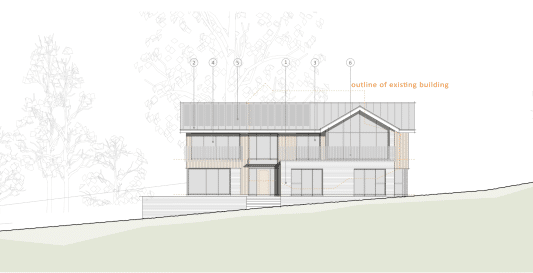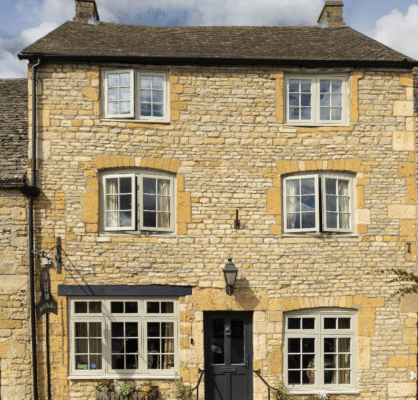

McLoughlin Planning is pleased to have helped a property owner secure Permission in Principle (PiP) with the London Borough of Sutton for an upward extension (airspace) development for 9 new flats. This is the first approved Permission in Principle granted by this London Borough.
Due to the significant number of reports and plans required through validation for full planning permissions, we have been approached by SME developers to find a means of managing development risk and to ensure the principle of their aspirations is something which can be agreed with the Council before investing in the technical work required. This is particularly applicable to constrained inner-city urban development sites where upward extensions for airspace development can be met with resistance.
Following previous success in London in using Permission in Principle, we worked with the landowner to develop a scheme which could be presented through a PiP to secure the principle of airspace development for the property. As this application type considers only the location, land use and amount of development, the level of supporting information is a fraction of a full planning permission. Whilst it does not remove the considerations and risks of subsequent technical considerations, it does provide an opportunity to agree with the Council whether the amount (i.e. number of residential flats) and location of the airspace development is acceptable. As PiP’s are limited to up to 9 residential units, this type of proposal is ideally suited for smaller development proposals in urban areas.
Following submission, McLoughlin Planning worked closely with the Council and case officer to ensure the proposal was being determined correctly and to agree with the officer on the appropriate amount of development which would be realistic to approve for further technical consent.
We are so pleased to have helped provide the landowner with reassurance through the PiP of their property’s development potential and to secure another first with a London Borough.

McLoughlin Planning has successfully obtained planning permission to demolish an existing dwelling and construct a larger replacement dwelling in the Tewkesbury Borough. The site’s location within the Cotswolds National Landscape (formerly the Cotswolds Area of Outstanding Natural Beauty) and particularly the Gloucester-Cheltenham Green Belt presented significant challenges to achieving the client brief. In partnership with Coombes:Everitt Architects and Willder Ecology –we secured the demolition of a dilapidated dwelling dating from the 1920s, and the construction of a larger contemporary replacement dwelling.
Defining the term ‘materially larger’ in the Green Belt? A holistic comparison can be key
Councils often provide inconsistent guidance or, more challenging still, no guidance at all in terms of the size of a replacement building one is allowed to construct in the Green Belt. The key planning policy test for this application was that the new dwelling could not be “materially larger” than the existing dwelling, which inevitably raised the question: what is meant by this subjective term?
McLoughlin Planning successfully negotiated with the case officer to agree that the proposed dwelling was not materially larger, thus allowing planning permission to be granted. One of the key lessons learnt from this project is that it is not simply a question of comparing the existing and proposed floor areas. The Council will also take into consideration the differences in height, footprint, and volume, in addition to floor area, when deciding whether a replacement building is “materially larger”. Providing a holistic comparison can be the difference between approval and refusal.
I own a property in the Green Belt – how can I obtain planning permission for my project?
We are absolutely delighted with the positive outcome on this project, which will turn an almost unusable dwelling into a well-designed home. The team at McLoughlin Planning are very experienced in the nuances surrounding these types of development projects and navigating the complexities of challenging land designations. If you have a project that might benefit from our expertise, then get in contact with one of our planning consultants to find out how we can best assist you.
Joe Seymour – Associate Director
E: joe.seymour@mplanning.co.uk
T: 01242895008
Image source: Coombes: Everitt Architects (2024)
Project Team:
McLoughlin Planning (Planning consultants)
Coombes:Everitt architects (Architects)
Willder Ecology (Ecologist)

We are delighted that following our involvement, planning permission has been secured for a garage conversion to enlarge the habitable living space of a mews house in the Royal Borough of Kensington and Chelsea (RBKC), despite a historic refusal on site for a similar scheme. The result of our recent planning approval will be the creation of a more spacious family home in a central and sustainable location, whilst also future proofing the building through important renovation works.
When a second opinion counts in planning
Our team was initially approached to assist following a planning refusal by RBKC for a similar scheme. The key concerns raised by the Local Planning Authority (LPA) related to:
As the property was centrally located in London, existing data advised us that surrounding streets were already heavily subscribed with parking permits and therefore could not afford the additional pressures. Furthermore, whilst garage conversions can, in some instances, be undertaken without the need for planning permission, a historic planning condition on the Mews property prevented the occupiers from benefiting from this opportunity.
Following a detailed review of the project, the previous refusal, the site’s context, and the relevant policies in the new Local Plan, we felt that there would be merit in revisiting the scheme and prepared a planning strategy for moving the project forward.
Turning a planning refusal into an approval – collaboration is key
Given the sensitive nature of the site, we worked closely with the team at Haine & Co Architects, to ensure that the revised design responded to the concerns raised in the previous planning refusal. The updated design sought to create a development which would be architecturally sympathetic to the age and character of the host building- reinforcing the original integrity of the site and its environs which was praised in the Officer’s Report. Furthermore, the additional space at the property would allow for a more comfortable living space and would make best use of the existing footprint.
Regarding the parking issues, we prepared and presented a case to the LPA that a Section 106 legal agreement could be used to make the development “car-free”, given the site’s highly sustainable location. This would assuage concerns over additional pressures to on-street parking in the vicinity.
Following submission of the application, we liaised regularly with the case officer, ensuring they had everything they needed to make a timely determination. Upon completion of the legal agreement, the Council acknowledged that the previous reasons for refusal had been overcome and that Planning Permission could now be granted.
The importance of a strategic planning approach
The above case is a useful reminder that a planning refusal does not necessarily mean that your development aspirations must come to a halt. Indeed, a refusal can help your proposals evolve, especially when combined with a strategic planning approach.
If you have recently had a planning refusal and would like a member of our team to review your case and explore whether there is a way forward to secure planning approval for your project, then please contact us through either our “Arrange a Call” tab on our contact page or via the email and telephone number provided below:
Chris Moore – Director
T: 01242895008
E: chris.moore@mplanning.co.uk

We are delighted to confirm that McLoughlin Planning was instrumental in obtaining planning permission for the change of use of a Bed & Breakfast (Use Class C1) into a new dwelling (Use Class C3).
The proposed change of use raised a number of key planning considerations which had to be carefully navigated, as the 18th century property is situated in a Conservation Area and within the Cotswold National Landscape.
But the main planning issue was related to the Principle of Development, given the property’s location in Stow’s defined town centre. This area is zoned for commercial uses, meaning new residential development is not usually supported. Despite this constraint, McLoughlin Planning was able to persuade Cotswold District Council that in this case, a residential use in the town centre was appropriate.
Our pragmatic approach, nuanced analysis of policy and site context, and the presentation of a strong fall-back position secured the planning approval for this change of use and the further evolution of this historic building, which will now become a family home.
Councils tend to have policies prohibiting new dwellings in town centre locations, mainly to ensure the ‘vitality and viability’ of the High Street is maintained. However, applications like this demonstrate it is possible to obtain permission for a dwelling in commercial centres. As our High Streets evolve, there is increasing recognition that the introduction of modest amounts of residential uses within town centres can contribute to, rather than diminish, the activity in town centres.
Do you own or are you interested in purchasing commercial property in a town centre with a view to changing its use to residential? If so, then please contact us through either our “Arrange a Call” tab on our contact page or via the email and telephone number provided below.
Joe Seymour – Associate Director
E: joe.seymour@mplanning.co.uk
T: 01242895008
Image source: Knight Frank Estate Agency
We have a simple objective: to get results for our clients by providing high quality planning consultancy. That means our goal is to secure planning permission or an allocation for development.
We have used McLoughlin Planning (London) on two or three occasions and found them efficient, knowledgeable and excellent at negotiating with Local Authorities and third parties. Their concise and specific advice helped us win approval for schemes which had previously been notified for refusal. We would not hesitate using them again for planning issues in London.
Rob Haine Haine & Co. Ltd.Having worked with Nathan and his team for a number of years, I have found he offers a rare combination of intellectual rigour and practical focus, coupled with a commercial approach. He is solution orientated and capable of delivering on accelerated timelines for clients at the highest level with exacting standards and positive results.
Craig Jordan Jordan HennessyI have known Nathan for over 10 years and have used his services to great effect where professionalism, tenacity and a clear focus have been required, to deliver successful results. With a cool head, aligned with attention to detail and commercial acumen, he and his team work effectively and diligently and we look forward to engaging on other projects in the future
Grant Westall-Reece AvantWorking with McLoughlin Planning has been very enjoyable. I have always found the team knowledgeable and easy to work with. They have always been professional and have managed to achieve the results desired.
Matt Richardson Legal and General HomesWe have used Nathan and his team to help with a range of planning matters on a number of occasions. I have always found them to be extremely helpful, responsive and proactive. Nathan always makes himself available for phone calls and or meetings. He is especially patient and good at explaining complex matters in a very user friendly way.
Mark Lawson The Buying SolutionWe have worked with McLoughlin Planning for many years and have always been very pleased with level of service in helping us navigate the ever-changing planning system. I also never cease to be impressed by the answers to the completely random questions I ask Nathan about possible new sites, normally in several different locations at one go.
Ian Hitchings Partridge Homes (Cotswolds) LtdAfter many years of working with Nathan and his team, we know we can trust their planning opinion. They often provide a solution that demonstrates Planning experience and expertise and the benefit of their input is measured by the planning approval success and infrequent need to go to appeal on a decision.
George Paton WebbPatonWe have consistently used McLoughlin Planning to successfully promote greenfield development sites in a variety of locations. Aside from their technical capabilities, we also value their considered approach to projects - particularly when dealing with delicate and complex planning issues. This makes them a natural part of our team.
Alistair Watson Welbeck Strategic LandIf you are interested in finding out how we can help you please get in touch